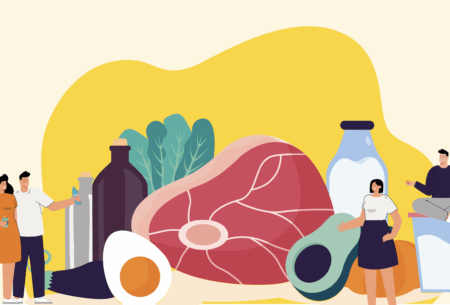Cow’s milk protein allergy (CMPA) is one of the most common allergies in infants. It can present in two different ways:
- an IgE allergy, where symptoms appear within minutes of eating the food or up to 2 hours after, or
- a non-IgE or delayed allergy with symptoms presenting 2-72 hours after ingestion of the food.
This allergy predominantly affects young children. The good news is that approximately 90% grow out of it by the age of 5 years.
What are the symptoms of CMPA?
For infants who have an immediate reaction, symptoms may include a skin rash, vomiting, or difficulties breathing however this is rare.
Infants with a delayed reaction may note gut symptoms including:
- increased wind
- constipation
- gastro-oesophageal reflux
- diarrhoea
- eczema
How is CMPA diagnosed?
A skin prick test (SPT) or a specific IgE antibody blood test (previously known as a RAST test) can be used to diagnose IgE mediated food allergies.
For non IgE mediated allergies there is no diagnostic test. Excluding the suspected allergen for 2-4 weeks and reintroducing while monitoring symptoms is the only way to diagnose a delayed allergy. Please note that the National Institute for Health and Care Excellence (NICE) recommends that no other diagnostic tests are used to diagnose food allergies.
This means no IgG food panel sensitivity tests which aren’t supported by robust scientific evidence!
How is CMPA managed?
A Paediatric Dietitian will provide dietary counselling to completely exclude sources of cow’s milk protein from the infant’s diet. This may be through adjusting the mother’s diet if they are a breastfed infant, or through obtaining a suitable prescription formula milk for the child to have if bottle fed. If the child is weaned then the paediatric dietitian will provide guidance and support to ensure you are confident in what your child can eat while meeting all their nutritional needs.
It is advised to avoid other mammalian milks and foods (including sheep and goat milk products) as the protein found in these is similar in structure to cow’s milk protein.
Note that lactose free products contain cow’s milk protein and are not suitable for those on a cow’s milk protein free diet.
As most children grow out of their cow’s milk protein allergy, this isn’t a usually a life-long exclusion. The reintroduction of cow’s milk into the diet should be managed and supervised by a paediatric dietitian.
Key nutritional considerations
When following a cow’s milk protein free diet (a type of exclusion diet), it is essential to consider key nutrients to reduce the risk of nutritional deficiencies. Here’s a summary of ones to watch:
Calcium
This is essential for bone health, and also important for our muscle contractions, regulating our heart rhythms, and blood clotting.
Dietary sources of calcium include:
- Fortified milk alternatives
- Nuts & seeds
- Fish with bones e.g. canned sardines
- Dried fruit e.g. apricots
- Green leafy vegetables e.g. spring greens, kale
- Fortified breakfast cereals
Vitamin D
Vitamin D helps calcium absorption in our body and plays a role in supporting our immune function. Take a look at our post on vitamin D here.
Dietary sources of vitamin D include:
- Egg yolks
- Mushrooms (pop them on a windowsill to boost the vitamin D content!)
- Oily fish
However, it’s important to note that vitamin D requirements are hard to meet through diet alone and supplementation is recommended for most of the population.
The Department of Health recommends:
- Children under 1 year should receive a vitamin D supplement containing 8.5-10µg/day (400IU) if breastfed or drinking <500mls formula per day.
- Children aged 1-4 years should be given a supplement containing 10µg/day (400IU) vitamin D daily.
- Breastfeeding mothers are also advised to take a supplement containing 10µg/day (400IU) vitamin D daily.
Iodine
This mineral is essential for thyroid hormones which help maintain control of the body’s metabolism. A breastfeeding mother will need to ensure they’re getting enough so that their milk contains enough iodine for the baby’s developing brain.
Dietary sources include:
- Fortified milk alternatives (check the label as not all of them have this added)
- White fish
- Seaweed*
*Note that whilst seaweed is a very concentrated source of iodine, it can provide excessive amounts and recommendations are to avoid eating it more than once a week, especially during pregnancy.
Summary
If you suspect your child has cow’s milk protein allergy, please liaise with your GP or health visitor. It is important to have support before excluding foods from your or your child’s diet.
Always liaise with a registered dietitian for assistance with this diet and to discuss the important process of reintroduction at the appropriate time.
We can help with cow’s milk protein allergy here at The Gut Health Clinic as we have 2 paediatric dietitians on the team.












